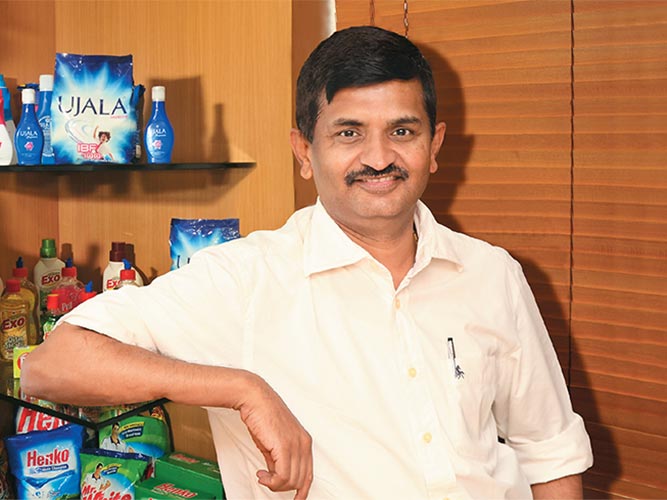S Raghunandan quit his comfy job as the country head of the UK-based consumer major Reckitt Benckiser in January 2012 to join as CEO of the home-grown Jyothy Laboratories a few months later. What made him go for the switch was the wider role being offered in his new assignment, unlike what he had been doing at Reckitt. A year later, Raghunandan is happy to have made that decision and that has largely to do with the performance he managed to dish out at Jyothy, widely known for its Ujala whitener brand.
To begin with, Jyothy never had a professional management in place and was largely run by the founder-promoter, MP Ramachandran, and joint managing director, Ullas Kamath. When Ramachandran roped in Raghunandan, the brief was very clear that he had to ensure a successful integration of loss-making Henkel, which the company had acquired last year, and that the new entity had to achieve revenues of ₹3,000 crore by 2015.
So far, Raghunandan seems to be on the right track. After taking over, the CEO put in place a clear business strategy by appointing business heads, streamlining the firm’s supply chain, revamping brands and making the case for higher advertising spend.
For the first time in 30 years, the company opted for a makeover of its ₹330-crore flagship brand, Ujala Supreme, in April this year. Jyothy revamped Ujala with new packaging and increased its price (a 75-ml bottle is now available for ₹17, up ₹2) to counter rival Hindustan Unilever, which had forayed into the fabric blue space with Rin and also launched liquid detergent under Surf Excel. Ujala is the market leader with 75% share of the ₹440-crore fabric blue market, while Reckitt Benckiser’s Robin Blue has 3.5% and HUL 2%. The revamp was accompanied by a new TV commercial, which changed the tagline from “Chaar boondon wala” to “Safedi ke aage Ujala”.
Paying off
After the new packaging and aggressive marketing, Ujala’s sales shot up by 37% in Q1FY14 (25% value growth and 10% volume growth). As a result, the overall contribution of the flagship brand’s portfolio increased from 16% in first quarter of last year to 20% in the first quarter of this year.
Under the Ujala umbrella are other brands such as Ujala Supreme, Ujala Washing Powder, Stiff and Shine, Ujala Techno Bright and a newly-launched premium detergent, Ujala IBF 100. In fact, Ujala IBF 100 is priced at ₹85/kg against ₹92 for Procter & Gamble’s Tide and Hindustan Unilever’s Rin Advanced at ₹76. Besides, the company, which has two businesses (soaps-detergents and home care), is now focusing on seven power brands — Ujala, Henko, Pril, Margo, Fa, Maxo and Exo.
Analysts believe the revamp is paying off. Tejashwini Kumari, an analyst from Angel Broking, says, “Ujala’s new branding has ensured a direct reach to the masses, which will be a major advantage for them. Besides, the launch of IBF 100 in the south will definitely benefit the company.” Going ahead, plans are afoot to relaunch Fa soap along with a premium liquid whitener.
Besides revamping the portfolio, the management also decided to cut distributor margins from 8% to 6% on all 10 brands; the company has around 1,700 distributors, 200 super stockists and over 2,000 sub-stockists. Similarly, retailers’ margins were revised from ₹10-15 earlier to ₹10. However, analysts see a downside to this move. “We believe Jyothy Laboratories would be unable to sustain revenue growth with low channel partner margins,” analysts Sanjay Manyal and Parineeta Poddar of ICICI Securities mentioned in a recent report. Raghunandan, though, counters this. “We were earlier giving very high margins but even at current levels we are offering much more than industry level. So, why will retailers not push our products?”
Further, streamlining the supply chain, the new CEO also consolidated manufacturing by shutting down plants in Bhubaneswar and Chennai and shifting production to Uttaranchal and Puducherry.
Raising the pitch
More importantly, the company ramped up its advertising and marketing budgets. Ad spend as percentage of sales increased from 8.1% in Q1FY13 to 12% in Q1FY14. For now, the higher spend has resulted in commensurate growth in sales (see: Showtime). “We are committing ourselves to spend as much as the industry spends on advertising and promotions as we believe this will fetch us higher returns,” says Raghunandan.
In FY13, Jyothy Laboratories recorded a 53% growth in revenues to ₹1,017 crore, but net profit fell to ₹44 crore owing to the merger of loss-making Henkel and brief absence of Ujala from stores shelves as the company went into a redesign mode. But in Q1 of FY14, sales were up 13% y-o-y, while profits bounced back over 100% to ₹29 crore. Analysts believe the momentum is in favour of the company. Aashish Upganlawar of Elara Securities believes that brands such as Henko, Ujala powder, Margo, Fa and Pril have market share (low single digits) and absolute sales far below their brand equity. “Management’s efforts on branding/distribution promise substantial growth over coming years,” states Upganlawar in a report.
Jyothy’s joint MD, Ullas Kamath, can’t help gush over the Q1 performance, “Bottomline improvement has come because of distribution changes, increase in prices and the product mix. Thanks to the new management team, it has paid off.” Now, Raghunandan and co are eyeing 25% increase in topline for FY14 and maintaining operating margins at 15%. But, how much of the optimism will translate into sustainable growth?











